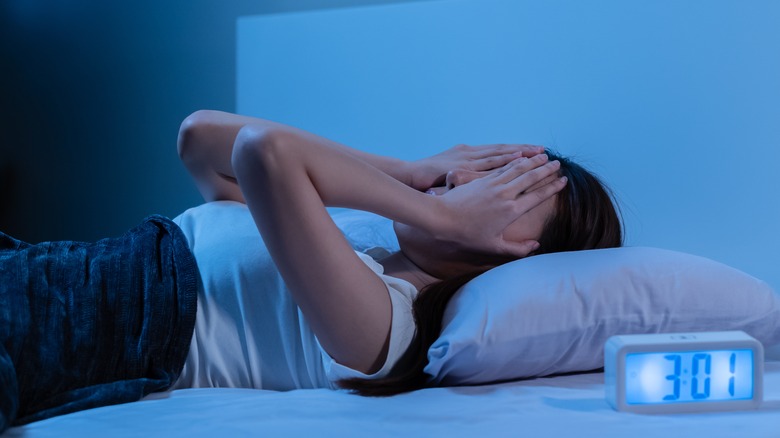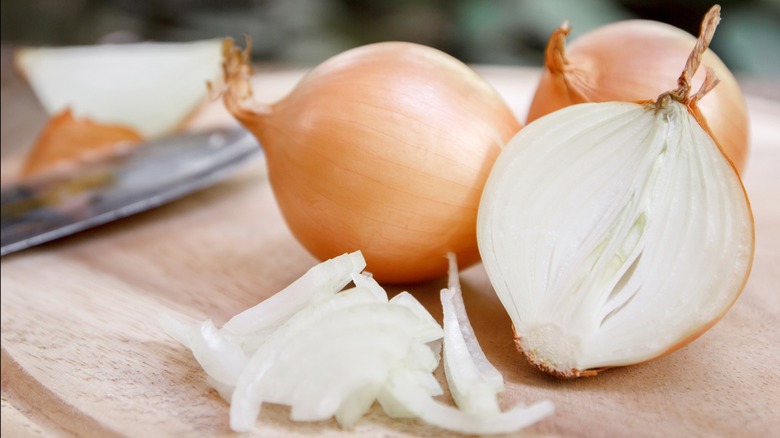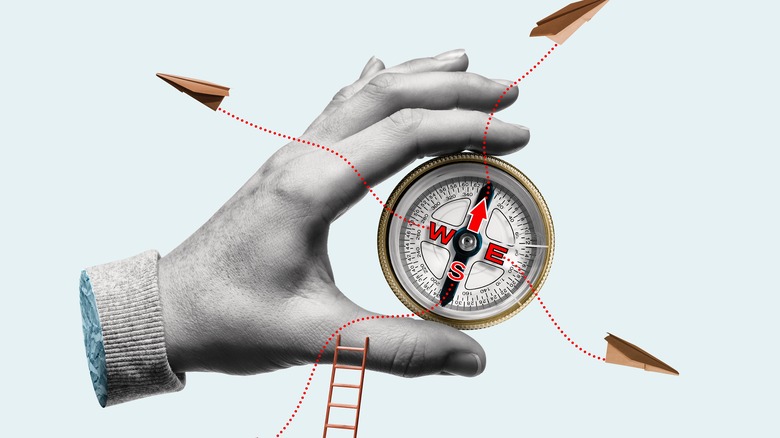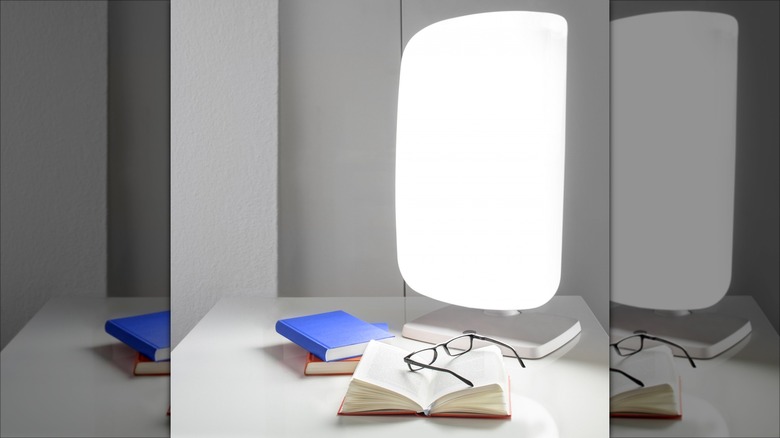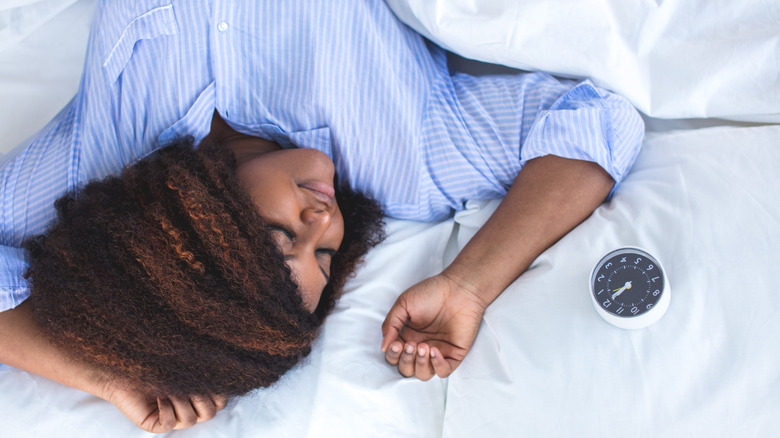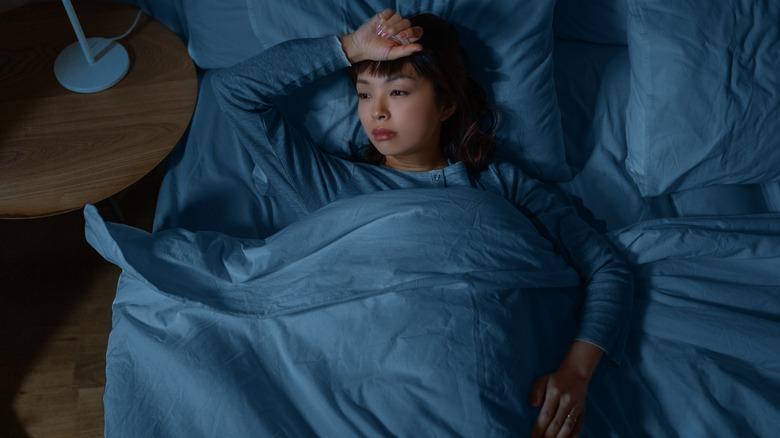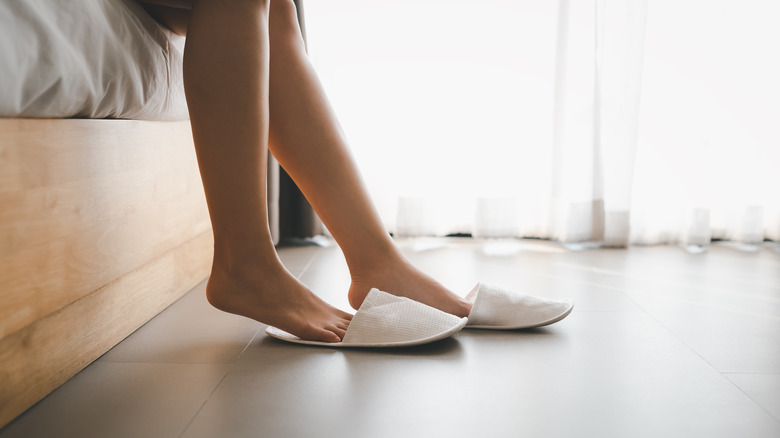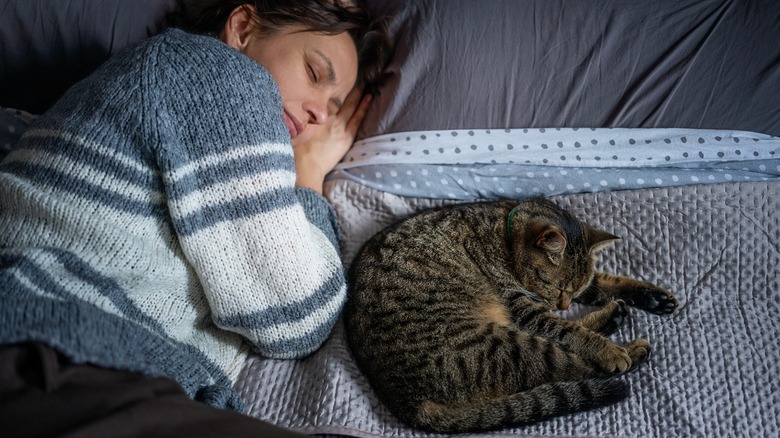Odd Cures For Insomnia You Never Thought Of
Counting sheep, drinking warm milk, eating ... lettuce? For as long as humans have been around, they've been sharing incredibly unusual cures for insomnia. There's nothing more frustrating than spending a night tossing and turning, and chronic insomnia is linked to a whole host of negative health issues that can have a cumulative effect. If you've tried traditional methods to encourage slipping into sweet, restorative slumber and haven't had any luck, you may just want to try some of the weirder tricks out there. Some solutions that are off the beaten path could just be worth a shot.
Of course, if a persistent lack of sleep is having a significant effect on your day-to-day, it's best to consult with your doctor to determine potential underlying causes and treatments. If your insomnia is fairly infrequent, though, we have some odd sleep hacks for you to try, as well as some just to entertain you. Hopefully, you'll be paying a much-needed visit to dreamland soon.
Eating raw onion before bed
Onions are loaded with an amino acid called L-tryptophan — the same compound found in turkey that many credit with post-Thanksgiving-dinner sleepiness. This amino acid is thought to be a natural sedative that contributes to the body's creation of serotonin and melatonin (two neurotransmitters most insomniacs are likely familiar with). L-tryptophan has been shown to enhance sleepiness and lessen the amount of time it takes to fall asleep, which are both coveted traits for anyone who's experienced a restless night.
Before you go chomping down on an onion apple-style, though, try other methods of getting the veggie down that are a little less aggro. Some swear by placing onion slices in a jar and opening up that bad boy up before bed to breathe in the vapors. Strange, yes, but arguably more pleasant than eating a raw onion. You can also brew onion tea, which entails boiling an onion (skin on is fine) in some water — skin on is fine — for about an hour. When it's ready, mix in some honey to improve the flavor. Alternatively, onion extract may help you catch some quality ZZZs, as a 2020 study published in Food Science and Biotechnology found.
If you tend toward heartburn or acid reflux, it's best to avoid ingesting onions, as it can contribute to flare-ups. Also, if you share your bed with a sensitive partner and are a considerate person, well, they may be happier if you explore other sleep hacks.
Sleeping with your head to the east
Another natural cure for insomnia may be as simple as changing the direction you sleep. According to the Indian architectural and design philosophy called vasu shastra, sleeping with your head facing north is a no-no. This is because, according to this school of thought, the head is akin to the North Pole of the body. Just like what happens when you put the same pole of two magnets together, there is a repellent property — this is believed to cause tension, which in turn makes it more challenging to fall asleep.
Facing your head east is instead the preferred sleeping direction. The principles of vasu shastra say this allows you to align with the energy of the sun, and is ideal for cultivating peaceful slumber and waking up refreshed. Alternatively, you can try placing your pillow toward the south. This is thought to encourage a harmonious exchange of energy that results in solid, restful sleep, as well as promoting prosperity, happiness, and health. And who wouldn't want that?
Light therapy
If you're seeking a cure for insomnia without supplements or medications, light therapy may fit the bill. It works to alter your circadian rhythm (your body's 24-hour internal clock), according to WebMD. This method can be particularly helpful if you have trouble falling asleep at the time you want — for instance, your schedule requires you to wake up early, but you find you're not able to conk out until late at night, even if you tuck yourself in on time.
You can opt to try a light box or light visor, which works by mimicking the light from the sun (minus the UV rays). In this treatment, you sit about 1.5 to 2 feet from your chosen light source for 20 to 30 minutes, depending on the strength of the device, a few times each day. This practice helps to reprogram your circadian rhythm and boost serotonin, which helps you feel more alert during waking hours. And as your body starts producing melatonin when it gets dark, you'll feel sleepier when bedtime rolls around.
Giving yourself 20-minute sessions to fall asleep
This method for encouraging sleep taps into stimulus control, a form of cognitive behavioral therapy — a practice that aims to retrain your brain out of unhelpful patterns of thought or behaviors to provide relief.
According to this method, if you've been trying to fall asleep for 20 minutes and it's not working, you should get out of bed and do a relaxing activity you enjoy. This can be reading, listening to a podcast, knitting — really anything that tends to quiet your mind. When you get to the point of feeling sleepy again, head back to bed. Again, give yourself 20 minutes to drift off. If you're still restless, get up and head back to a relaxing activity (the same one as before or a different one).
The goal is that, rather than spending time in bed struggling to sleep, you'll stop this negative bedtime cycle in its tracks. Incorporating this habit into your sleepytime routine is thought to encourage more solid snoozing, and it gives you greater control over the whole endeavor, which feels better than languishing in that restless state in bed.
Consuming lettuce in various forms
You may have seen the viral TikTok trend praising the benefits of lettuce water to encourage sleep. Well, the practice of incorporating this veg to bring on ZZZs goes back to the ancient Egyptians and Romans. These cultures tended to finish off their meals with lettuce to encourage calmness and sleepiness — and it was also used as an aphrodisiac (pick a lane, guys!). Further, according to Calm, eating fried lettuce was a folk remedy employed by the French as, yes, a way to cure insomnia.
There is some science behind this method. A sleep-enhancing compound called lactucarium is found in lettuce — it's a milky secretion primarily produced at the stem base of the vegetable. It's also known as lettuce opium, and it can have a sedative and even hypnotic effect. Before you go chomping down on iceberg leaves, it should be noted this compound is stronger in other varieties, especially red romaine.
Today's adaptation of using lettuce to fall asleep is to boil the vegetable into a tea, but be forewarned — sipping this before bed may cause you to have to get up at night to pee, which is a definite sleep-disturber. It's possible the sleep-enhancing effects you see on TikTok may be more the result of the placebo effect, but even so, it won't hurt to try this unusual "cure." If it works for you, kudos.
Tricking your brain to take the pressure off sleeping
This cognitive behavioral therapy method works by getting the better of your active brain. Instead of trying to will yourself to sleep, which can often backfire, you essentially trick your brain by telling yourself you're trying to stay awake.
As sleep scientist Katharina Lederle told Glamour UK, "If we fear something, we do everything we can to try and avoid it." S buildup of anxiety around trying to get to sleep often results in sleep slipping further out of reach. This paradoxical intention practice is all about stopping that merry-go-round.
To try it: From bed, tell yourself you'd like to stay awake a little longer. Although you shouldn't get into lively activities or force yourself into wakefulness, this little brain hack can sometimes do just the trick. It works because, according to Dr. Lederle, "By giving up on the aim to fall asleep, you stop putting in the 'effort' to fall asleep, and that means the pressure to 'perform' (i.e. fall asleep) disappears. Physiologically, this means the body and brain can finally calm down and relax."
Using hypnosis to change your focus
More than a swinging pocketwatch in your face getting you to act in bizarre ways, hypnosis can be an effective method to achieve behavioral changes. It's often utilized to help with breaking habits like smoking or even managing pain control. Though professionals suggest it works best under the guidance of a trained hypnotherapist, you can also potentially achieve benefits with self-hypnosis by using video or audio sources, like an app, according to the Sleep Foundation.
This process promotes relaxation and reorients negative thoughts and feelings, and it can reduce the noise caused by anxiety and depression, which are often enemies of a good night's sleep. Hypnosis uses visualization to direct focus to calming thoughts or images, then deepening that level of relaxed focus. Next, the listener receives therapeutic suggestions geared toward falling asleep.
Hypnosis is more effective on certain people, but it can be a solid option for those who have racing thoughts at night or tend to stress out over bedtime, as it can calmly direct your mind to slumber.
Getting real weird with animal-based 'cures'
When it comes to the most bizarre of insomnia treatments, history provides a number of options that are mighty weird — and downright gross. The restfulness authorities over at Calm compiled a bunch of the world's wildest cures for sleeplessness, and though their effectiveness is subject to your own discretion, stomach, and ability to get your hands on this wacky stuff, they are definitely odd.
After surveying people on different cures, Calm found that participants most often rated smearing dog earwax on the teeth as the weirdest — and we'd agree. Credited to Italian Renaissance mathematician and physician Gerolamo Cardano back in the 16th century, the reasoning behind this method isn't entirely clear. One thing is obvious, though — he must have been one sleepless dude to experiment with Fido's floppy ears.
Another unusual cure is eating sea slug entrails, a folk remedy out of Japan. These are a delicacy in Japan, though, and perhaps a worthy fit for someone with an adventurous spirit. The Romans threw their own unusual suggestion into the mix — rubbing the fat of a field mouse on the soles of their feet. And, not to be outdone, medieval Europeans advised sipping a concoction made with castrated boar bile. Yum.
We'd argue that there are far better (and more palatable) ways to fall asleep so, you know, maybe skip these cures.
Limiting the time you spend in bed
Back to another cognitive approach to better snoozing, this method — sleep restriction — sounds counterintuitive but has been shown to produce results in just a week, according to Stanford Medicine. Sleep restriction requires you to stay in bed only for as long as you tend to sleep — i.e., if you only sleep six hours a night but toss and turn (or lounge around) awake in bed before or after sleeping, don't. Only allow yourself those six hours in bed.
Initially, you may feel sleepier during the day, but this method is said to improve the (time-restricted) sleep you do have. After a week or so — as long as you're sleeping through the night with minimal interruption — yo'llu gradually extend your time in bed by 15 to 30 minutes. Allow your body to acclimate to each added chunk of time for at least another week, and continue increasing as you adjust. If you return to experiencing unwanted wakefulness, go back to restricting time in bed to the average number of hours you're actually asleep. The goal is to discover the optimal amount of time to devote to bed and then stick with that magic number.
Oh, and regardless of how little you sleep, don't restrict yourself to any less than 5.5 hours.
Getting your sleep in smaller chunks
For some people, consistent naps just work better than aiming to sleep through the night. This is especially true for those who work off-hour schedules. Called polyphasic sleep, this method entails getting your sleep in two or more chunks per 24-hour period. Comparable to how infants (or even cats and other animals) get their sleep, this can look like a couple of longish naps during the day and a relatively short time sleeping overnight. Polyphasic sleep could also consist of multiple 20-minute naps, or even sleeping in three stages — before dawn, at some point in the afternoon, and after sunset.
However, you will likely fall short of the recommended seven to nine hours of sleep per night if you follow this method. Although polyphasic sleep may be effective initially for some, it often isn't sustainable. Nevertheless, some people just tend toward this style of sleep. Provided you feel alert during your waking hours — and enjoy likely having more of them — polyphasic sleep may be a dream cure for insomniacs.
